-
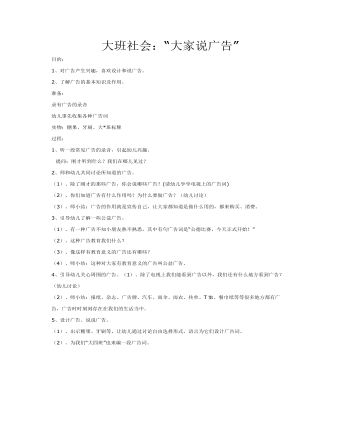
大班社会教案:大家说广告
2、了解广告的基本知识及作用。准备:录有广告的录音幼儿事先收集各种广告词实物:糖果、牙刷、大*班标牌过程:1、听一段常见广告的录音,引起幼儿兴趣。 提问:刚才听到什么?我们在哪儿见过?2、师和幼儿共同讨论所知道的广告。(1)、除了刚才的那些广告,你会说哪些广告?(请幼儿学学电视上的广告词)(2)、你们知道广告有什么作用吗?为什么要做广告?(幼儿讨论)(3)、师小结:广告的作用就是宣传自己,让大家都知道是做什么用的,都来购买、消费。
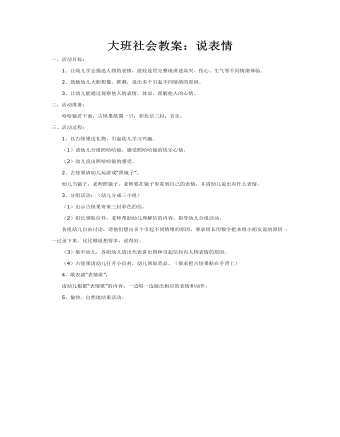
大班社会教案:说表情
二、活动准备: 哈哈镜若干面;古怪果纸偶一只;彩色信三封;音乐。三、活动过程:1、以古怪果送礼物,引起幼儿学习兴趣。 (1)请幼儿分组照哈哈镜,感受照哈哈镜的快乐心情。 (2)幼儿说出照哈哈镜的感受。2、古怪果请幼儿玩游戏“照镜子”。 幼儿当镜子,老师照镜子,老师要在镜子里看到自己的表情,并请幼儿说出有什么表情。3、分组活动:(幼儿分成三小组) (1)出示古怪果寄来三封彩色的信。
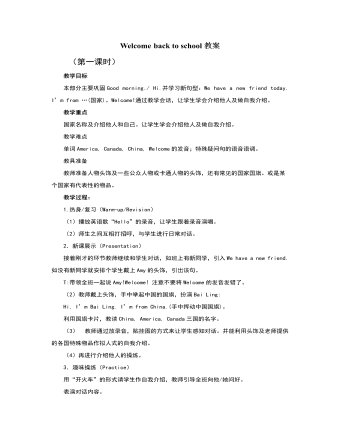
人教版新课标PEP小学英语三年级下册Welcome back to school教案
教学过程:1.热身/复习(Warm-up/Revision)(1)教师用肢体语言表示出字母,让学生猜出字母,并大声读出。(2)出示字母卡,学生认读,并提问学生回忆以它开头的单词。(3)放A部分Let’s chant的录音,学生有节奏地跟唱歌谣。2.新课展示(Presentation)(1)出示字母卡学习Dd,再单独呈现大写或小写,反复教读。用同样方法教读Ee。(2)出示以这两个字母为首字母的单词图片,问学生:What’s this ?回答:It’s a duck .教读duck,dog,egg,elephant。注意egg是an egg,不是“a egg”.(3)放Let’s say部分的录音,学生跟读。3.趣味操练(Practice)(1)呈现大写或小写字母的趣味图片,让学生认读。(2)让学生发挥想象,说出这些字母 像什么。(3)教师按笔顺书写字母,让学生观察后按笔顺书写字母。(4)游戏:找朋友游戏:看谁站得快学生手执卡片,听教师发令后,产成一排,下面的学生边读边检查。
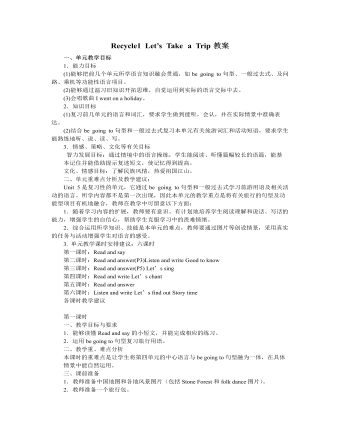
人教版新课标PEP小学英语六年级下册Recycle1 Let’s Take a Trip教案
4.巩固和扩展(Consolidation and extension) (1) 做本单元活动手册配套练习。 (2) 翻卡片说单词。学生两人一组,把单词卡片反面朝上放在桌子上,然后同时翻开两张单词卡(如:going, holiday),就马上组织成一句话(如:Where are you going on the holiday?/ I’m going to Kunming this holiday.),说得快又正确者为胜。 (3) 教师播放C部分Story time的录音或VCD,帮助学生理解故事内容。学生再听一遍录音,跟读故事里的句子,教师指导学生发音。 (4) Bright eyes. 在黑板上张贴Let’s find out的8幅图片,Mike, Zhang Peng, Sarah, Kathy等4个人物图片分别放在8幅图片上,如:Mike ---take pictures---buy presents。学生仔细观察后,请学生闭上眼睛,教师就趁学生闭眼之际交换人物位置(如把Mike放到eat noodles),然后请学生张开眼睛回答:What did Mike do just now ? 引导学生回答: Mike took pictures and bought presents. 教学参考资料库 1.文化背景介绍: 机场标志: Airport 飞机场 Airport lounges 机场休息室Airports shuttle 机场班车 Arrivals 进港Assistance 问讯处Check in area (zone) 办理登机区Departure airport 离港时间Departure times on reverse 返航时间 Welcome aboard 欢迎登机
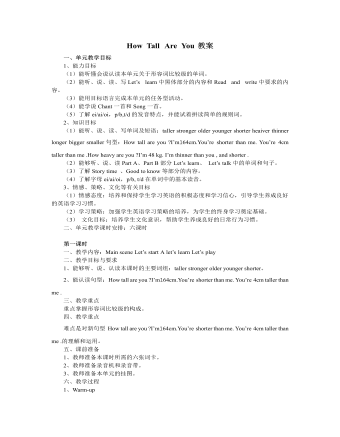
人教版新课标PEP小学英语六年级下册How Tall Are You教案
(1)呈现猴子图片,初步接触知识.教师在发指令时,加入 Touch your tail.当学生觉得茫然时,老师趁机出示课件(一只猴子)Look,We have no tails,but the monkey has.Look at the monkey,How long is the tail?在课件上呈现数据38cm.学生回答:Its tail is38cm long.根据教材内容教师提问:How tall is the monkey?学生:It’s 40cm tall.老师自己引出only一词,注意这个词的发音.多媒体再出示两只猴子的图片,一只黄色,一只棕色,让学生加以比较.教师问:Which monkey do you like?The yellow one or the brown one?【设计思路】 学生在回答这些问题时,也同时在复习前两课时所学内容,起到知识循环的作用.(2)猜一猜游戏:它们有多高?让学生猜一猜这两只猴子的身高.注意提示学生用上I think….这一句型,表示自己的猜测.在这里也可安排一个竞赛,看谁能猜中正确数据,教师让一些学生猜后出示数据.【设计思路】 学生对有悬念的东西都特别感兴趣,在此不仅练习了两位数的读法,又满足了学生的好胜心理.
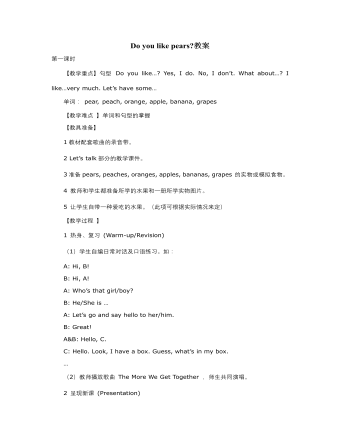
人教版新课标PEP小学英语三年级下册Do you like pears教案
教师扮做客人,让孩子根据问题做出反应并回答。 Can I have an apple? Can I have some grapes? Let’s sing 播放歌曲的录像,先观看一遍, 帮助孩子理解歌曲。 孩子边唱边表演。 小组表演,小组展示。 (四) 扩展性活动(Add-activities) Coloring Draw some grapes, color them red Draw a banana,color it green. …, …【板书设计 】Do you like pears? Do you like pears? 第五课时第六课时【课题】Do you like pears? 第六课时 【教学重点】听、说、认读字母Rr Ss Tt,体会字母在单词中的发音 【教学难点 】字母Ss的发音。Tiger中字母I的发音 【教具准备】 1、本课生词的单词卡片 2、配套的教学课件 3、相配套的教学录音带 4、学生的小英语练习本 5、大字母卡片,每组一套的小字母卡片 【教学过程 】 (一)热身/复习(Warm-up/Revision) 1、Let’s sing 演唱B部分的歌曲,边唱边演。
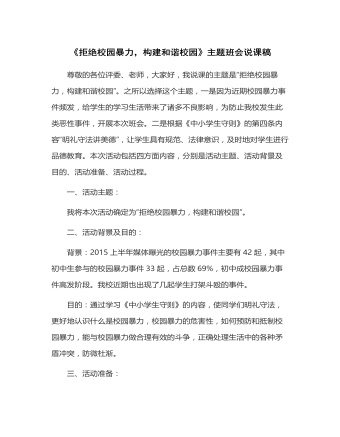
《拒绝校园暴力 构建和谐校园》主题班会活动说课稿
4月19日,湖北红安00后为争女朋友斗殴,操板砖砸人手段凶残。 4月30日,福建南安一初一男生被同校学生及社会青年追打,捅伤。 5月12日,福建晋江学生校外打架一死两伤。 5月19日,辽宁沈阳宁官实验学校篮球暴力事件。 6月16日,山东济南一中学多名学生暴力殴打同校学生。 6月21日,湖南怀化一女生在校园遭8名学姐群殴致耳膜穿孔。 6月26日,河南信阳数百中学生赤膊群殴。(二)抵制校园暴力此环节设置三个问题,这三个问题分别是:1、同学间发生矛盾时,作为当事人,我们应该如何解决?2、矛盾一时难以解开,如何有效扼制校园暴力的发生?3、一旦发生校园暴力事件,如何应对?这三个问题,分别是从学生间出现矛盾时、校园暴力发生前、校园暴力发生中三个不同阶段提出的,能够让学生思考在不同情况下如何处理矛盾,并尽可能的避免校园暴力的发生,一旦发生校园暴力,也能够及时采取措施避免伤害。最后师生共同总结出避免校园暴力的做法: 从受害者的角度想:不理睬;找老师;懂自救。 从施暴者的角度想:想后果;勿冲动;换位思考。
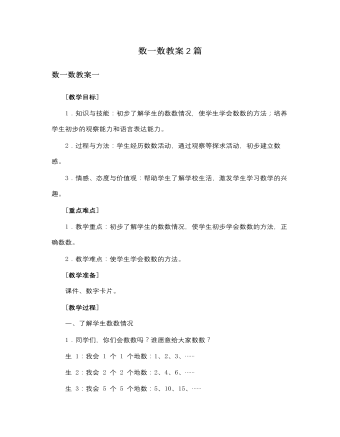
人教版新课标小学数学一年级上册数一数教案2篇
[在学生数的过程中再加强点数的指导,同时有意识的培养学生按顺序数数。另外,在数六朵花、八棵树、九名女生、十名男生的时候,除了 1 个 1 个地数以外,还可以引导学生 2 个 2 个地、3 个 3 个地、4 个 4 个地、5 个 5 个地数数,为后面学习 10 以内各数打基础。] (2)小组进行交流。 再从 1~10 数一数物体的个数。 (3)认一认。 师:你认识这些数吗?边指边读给大家听听。 生:边指 1~10 各数边读一读。 三、巩固练习 1.结合实物,开展数数活动。 (1)按要求数出下面物体的个数。 师:同学们刚才数得真不错!你们愿不愿意数一数自己文具盒中有几支铅笔呀? 生:数出自己文具盒中有几支铅笔并汇报。 师:请同学们数一数你的书包里共有几本书? 生:数出自己书包里共有几本书并汇报…… (2)自由数物体的个数。 师:你还想数哪些物体的个数?和同桌的小伙伴交流一下。
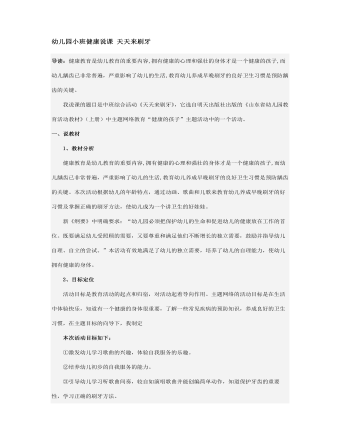
幼儿园小班健康说课 天天来刷牙
1、教材分析 健康教育是幼儿教育的重要内容,拥有健康的心理和强壮的身体才是一个健康的孩子,而幼儿龋齿已非常普遍,严重影响了幼儿的生活,教育幼儿养成早晚刷牙的良好卫生习惯是预防龋齿的关键。本次活动根据幼儿的年龄特点,通过动画、歌曲和儿歌来教育幼儿养成早晚刷牙的好习惯及掌握正确的刷牙方法,使幼儿成为一个讲卫生的好娃娃。 新《纲要》中明确要求:“幼儿园必须把保护幼儿的生命和促进幼儿的健康放在工作的首位。既要满足幼儿受照顾的需要,又要尊重和满足他们不断增长的独立需要,鼓励并指导幼儿自理、自立的尝试。”本活动有效地满足了幼儿的独立需要,培养了幼儿的自理能力,使幼儿拥有健康的身体。 2、目标定位 活动目标是教育活动的起点和归宿,对活动起着导向作用。主题网络的活动目标是在生活中体验快乐,知道有一个健康的身体很重要,了解一些常见疾病的预防知识,养成良好的卫生习惯。
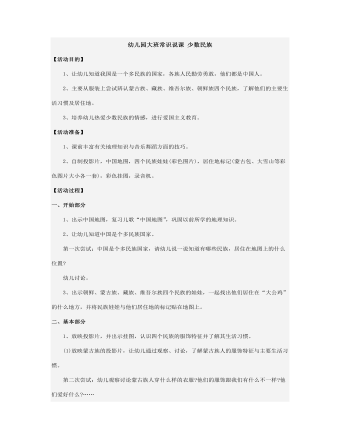
幼儿园大班常识说课 少数民族
开始部分主要是利用幼儿的以往经验,从复习儿歌认识中国地图开始,知道中国是个多民族的国家(重点是让幼儿知道除了汉族外,其他的各个民族都是少数民族。教师用意在使幼儿理解民族大团结),引入本课的具体内容,(请来四个做客的民族娃娃,让幼儿猜一猜他们来自哪里,客人说出自己从哪里来)认识四个民族在地图上的大概位置。这样通过大地图(中国)→许多民族→四位客人。一步步深入到课题,吸引幼儿,激发幼儿学习的欲望。 基本部分是让幼儿认识各民族的服饰特征与生活习惯,通过认识、巩固加深幼儿印象。可以先让幼儿观察幻灯片,由教师的导语让幼儿尝试,进一步仔细观察挂图,在幼儿回答的基础上由教师小结,由此培养幼儿的观察能力与表达能力。然后是复习巩固,通过自制幻灯片的添色游戏,调动幼儿兴趣,快速辨认并参与游戏,这样幼儿既动手参与了游戏、活跃了课堂气氛,又复习了新课。最后为了丰富知识,让幼儿大致了解他们的音乐及舞蹈,这样满足孩子爱唱爱跳的欲望,培养音乐的感受力及欣赏、创编的能力,老师应跳出各民族的舞蹈风格,用情绪与动作感染幼儿,活跃课堂气氛。
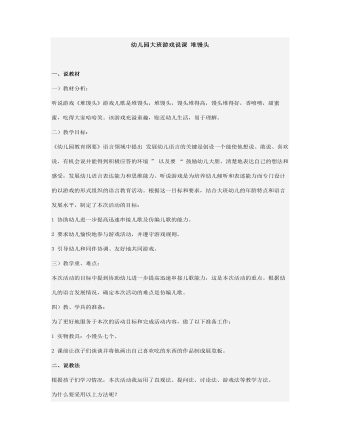
幼儿园大班游戏说课 堆馒头
《幼儿园教育纲要》语言领域中提出 发展幼儿语言的关键是创设一个能使他想说、敢说、喜欢说、有机会说并能得到积极应答的环境 ” 以及要 “ 鼓励幼儿大胆、清楚地表达自己的想法和感受,发展幼儿语言表达能力和思维能力。听说游戏是为培养幼儿倾听和表述能力而专门设计的以游戏的形式组织的语言教育活动。根据这一目标和要求,结合大班幼儿的年龄特点和语言发展水平,制定了本次活动的目标:1 协助幼儿进一步提高迅速串接儿歌及仿编儿歌的能力。2 要求幼儿愉快地参与游戏活动,并遵守游戏规则。3 引导幼儿和同伴协调、友好地共同游戏。
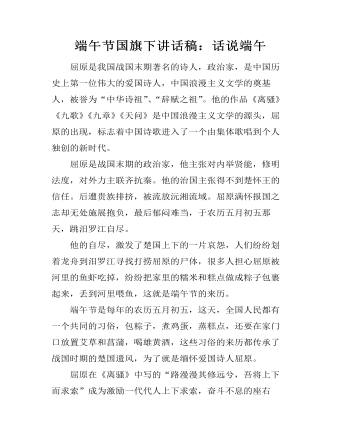
端午节国旗下讲话稿:话说端午
屈原是我国战国末期著名的诗人,政治家,是中国历史上第一位伟大的爱国诗人,中国浪漫主义文学的奠基人,被誉为“中华诗祖”、“辞赋之祖”。他的作品《离骚》《九歌》《九章》《天问》是中国浪漫主义文学的源头,屈原的出现,标志着中国诗歌进入了一个由集体歌唱到个人独创的新时代。屈原是战国末期的政治家,他主张对内举贤能,修明法度,对外力主联齐抗秦。他的治国主张得不到楚怀王的信任。后遭贵族排挤,被流放沅湘流域。屈原满怀报国之志却无处施展抱负,最后郁闷难当,于农历五月初五那天,跳汨罗江自尽。他的自尽,激发了楚国上下的一片哀怨,人们纷纷划着龙舟到汨罗江寻找打捞屈原的尸体,很多人担心屈原被河里的鱼虾吃掉,纷纷把家里的糯米和糕点做成粽子包裹起来,丢到河里喂鱼,这就是端午节的来历。
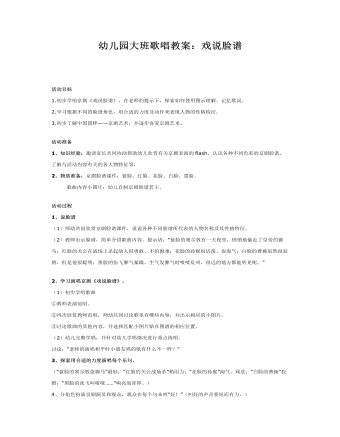
幼儿园大班歌唱教案:戏说脸谱
2.学习根据不同的脸谱角色,用合适的力度及动作来表现人物的性格特征。 3.初步了解中国国粹——京剧艺术,并逐步喜爱京剧艺术。活动准备 1、知识经验:邀请家长共同协助帮助幼儿欣赏有关京剧表演的flash、认识各种不同色彩的京剧脸谱、了解与活动内容有关的各人物特征等, 2、物质准备:京剧脸谱课件:蓝脸、红脸、花脸、白脸、黑脸。 歌曲内容小图片;幼儿自制京剧脸谱若干。 活动过程 1、说脸谱 (1)师幼共同欣赏京剧脸谱课件,说说各种不同脸谱所代表的人物名称及其性格特征。

幼儿园大班亲子教案:我说一,谁对一
活动准备:各种动物的图片 活动建议:家长和孩子面对面坐着,一边拍手,一边说儿歌。 可以有几种形式: 开始的时候,家长说,孩子对 当孩子对儿歌的内容基本了解后,家长与孩子一起说。 当孩子把儿歌的内容都记住了,让孩子说,家长对。 当这首儿歌熟悉后,可以适当改变内容,如哪个爱在水里游,可以回答“鸭子爱在水里游”,也可回答“鱼儿爱在水里游”。

新人教版高中英语必修2Unit 2 Wildlife Protection-Reading for Writing教案二
This lesson aims at making a poster about protecting wildlife after reading some posters. During reading students are guided to understand the content and try to summarize the posters with one sentence. Then students are guided to try to make a poster about protecting wildlife.1. Read the two posters and try to understand the summary sentences.2. Look at the two posters and try to understand what emotions they express.3. Try to summarize the features of posters4. Try to make a poster about wildlife.1. Look at the two posters and try to understand what emotions they express.2. Try to summarize the features of posters3. Try to make a poster about wildlife.Step 1 Lead inLook at the the posters on the textbook and ask:Which emotions do the posters communicate ?Step 2 Read the poster and answer the questions.1. What do you think of the animals in the poster on the left ?I think it is frightening and ugly.2. Why do we should protect the ugly animals ?All species--the good, the bad, and the ugly-- should be treated equally.The world needs all kinds--without variety, our planet cannot survive.3. Why are billions of trees being cut down every year ?To make paper for humans.4. What result will be lead to after the trees are cut down ?A lost of animal homes are being destroyed./The habitat of wildlife is being destroyed.Step 3 Find the feature of posters1. What does each poster use to stir up emotions ?On the left, it makes us a little frightened and it looks a little ugly, but it can activate our curiosity--What is it? And What is wrong with it?On the right, it makes us feel a little sad and want to protect them.

新人教版高中英语必修2Unit 2 Wildlife Protection-Discovering Useful Structure教案二
2.表示现阶段正在进行的被动动作(该动作在说话的瞬间未必正在进行)。Many interesting experiments are being carried out these days.(说话时,并不一定正在进行)3.表示一种经常性的被动行为,常和always,constantly 等表示频度的副词连用,这种用法常常带有赞扬或厌恶的感情色彩。He is always being praised by the leader.4.表示按计划或安排主语将要承受谓语动词所表示的动作(仅限于少数及物动词)。A party is being held tonight.Step 4 Special cases1.像take care of, look after, talk about, think of等动词与介词构成的短语用于现在进行时的被动语态时, 其中的介词不可省略。The ways to stop illegally hunting are being talked about. 2.可与部分情态动词连用,表示对正在发生的事情的推测。She may be being punished by her mother.3.有时可表示按计划或安排将要进行的一个被动动作。A celebration is being held this weekend for his success.4.某些表示“状态、心理活动、存在”等的动词,如have,want,need,love,一般不用现在进行时的被动语态,而常用一般现在时的被动语态。With the population increasing,more land is needed.5.“be+under/in+n.”可表示现在进行时的被动意义。My computer is under repair.=My computer is being repaired.

新人教版高中英语必修2Unit 2 Wildlife Protection-Discovering Useful Structure教案一
The activity topic of this section is "report an ongoing event", and the structure is the passive voice of present continuous tense. Rare wild animals are suffering from large-scale poaching, and species are on the brink of danger. Rescue operations are underway. "Being" and "suffering" are the meanings of the present progressive passive voice.The usage of present progressive passive voice is of great importance in writing a good discourse and appreciating some difficult language items, so it is vital to master it and use it flexibly in a context.1. Motivate Ss to deepen the understanding of the usage of present progressive passive voice in a fixed context.2. Enable Ss to master the usage of present progressive passive voice and use it flexibly in a context.3. Lead Ss to construct sentences or appreciate sentences used master it and use it flexibly in a context.1. Help students to appreciate the function of the usage of present progressive passive voice in a sentence2. Instruct students to write essays using the proper usage of present progressive passive voice.Look at the picture and tell me what are workers doing? What is the house being done?

新人教版高中英语必修2Unit 2 Wildlife Protection-Reading and Thinking教案一
The listening and speaking part aims at how to protect and help endangered animals by listening, speaking and talking about the facts and reasons. This lesson analyzes the decreasing clause of Tibetan antelope population and the measures of protecting Tibetan antelopes. So students can be guided to learn to analyse the title and use different reading skills or strategies, like scanning, skimming and careful reading.1. Read quickly to get the main ideas and the purpose of going to Tibetan; read carefully to understand what the author see and think.2. Understand the sentences of the present continuous passive voice such as “Much is being done to protect wildlife.” and the inverted sentence “Only when we learn to exist in harmony with nature can we stop being a threat to wildlife and to our planet.”3. Enhance the awareness of protecting wildlife.4. Cultivate the reading methods according to different materials.1. Read quickly to get the main ideas and the purpose of going to Tibetan; read carefully to understand what the author see and think.2. Understand the sentences of the present continuous passive voice such as “Much is being done to protect wildlife.” and the inverted sentence “Only when we learn to exist in harmony with nature can we stop being a threat to wildlife and to our planet.”3. Cultivate the reading methods according to different materials.Step 1 Leading-inWatch a video about elephants and whales and then ask:Why are they endangered ? They are killed/hunted

新人教版高中英语必修2Unit 2 Wildlife Protection-Listening &Speaking&Talking教案
Listening and Speaking introduces the topic of “how to save endangered wildlife and help wildlife in their neighborhood.” Due to the continuous deterioration of the living environment, a large number of wild animals are always facing the threat of endangered or extinction. Listening and speaking period enables students to understand the fact and reason why wild species are disappearing from the earth at an amazing speed, and realize that human beings ought to enhance the awareness of protecting wild species as soon as possible.Listening and Talking introduces the theme of " how to help wildlife in Ss’ neighborhood.". Now there are many volunteers who spontaneously protect wild animals, carry out various activities according to local conditions, and contribute their own strength to local animal protection with practical actions. Middle school students are also enthusiastic participants. They organize activities in their spare time, and take this opportunity to make friends, broaden their horizons, cultivate team spirit and communication skills. This section describes a bird watching activity organized by several middle school students of Bird watching Club. It aims to stimulate students' interest, improve their understanding of bird watching activities, and use the language structure of “being used for; in order to, so as to, to, so that, in order that ” to express the purpose for communication and discussion.1. Guide students to understand the content of listening texts in terms of using visuals to predict content.2. Cultivate students' ability to guess the meaning of words in listening; discuss with their peers how to save endangered wildlife and help wildlife in their neighborhood.3. Instruct students to use functional sentences of the dialogue such as “I am concerned about…” “what do you know about the endangered animals in…" and so on to talk about one of the endangered animals.

新人教版高中英语必修2Unit 2 Wildlife Protection-Listening and Speaking教案
This lesson is about wildlife protection. The listening and speaking is about “How to protect endangered wildlife ?” Faced with the facts and numbers of wildlife loss, people begin to detect the reasons, then people such as the celebrities (Prince William and Yao Ming) are calling on to protect them. So students are guided to enhance the awareness of protecting wildlife and try to take part in some volunteer activities of protecting wildlife.1. Predict the content by using visuals. 2. Learn to use the sentences such as “I’m concerned about.... But now they are in danger. I want to know the reasons/why./ What can we do to protect them ?3. Learn from the stars like Prince William and Yao Ming and enhance the awareness of protecting wildlife.4. Guide students to try to put forward the solutions to the problems of wildlife protection and then discuss them with partners and present the results of discussion.5. Master the pronunciation of stressed syllables.1. Learn from the stars like Prince William and Yao Ming and enhance the awareness of protecting wildlife.2. Guide students to try to put forward the solutions to the problems of wildlife protection and then discuss them with partners and present the results of discussion.3. Learn to use the sentences such as “I’m concerned about.... But now they are in danger. I want to know the reasons/why./ What can we do to protect them ?4. Master the pronunciation of stressed syllables.Part A Listening and Speaking--- How to save endangered wildlifeStep 1 Lead in1. Point at the pictures on P14 and ask Q1: What message do these posters share?

